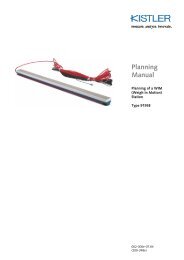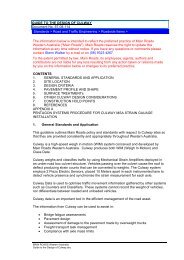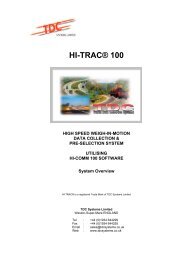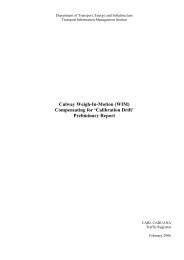AP-G84/04 Best practice in road use data collection, analysis ... - WIM
AP-G84/04 Best practice in road use data collection, analysis ... - WIM
AP-G84/04 Best practice in road use data collection, analysis ... - WIM
You also want an ePaper? Increase the reach of your titles
YUMPU automatically turns print PDFs into web optimized ePapers that Google loves.
Accessed by AR - ARRB TRANSPORT RESEARCH on <strong>04</strong> Feb 2005<br />
Aust<strong>road</strong>s 20<strong>04</strong><br />
— 11 —<br />
<strong>Best</strong> Practices <strong>in</strong> Road Use Data Collection, Analysis and Report<strong>in</strong>g<br />
(b) Vehicle concatenation – When the space between two consecutive vehicles is small, it<br />
becomes difficult to separate the two vehicles us<strong>in</strong>g, say, a standard two axle sensor<br />
classifier. Where very high accuracy is required <strong>in</strong> a traffic operation (e.g. toll <strong>collection</strong>), a<br />
loop sensor may be <strong>use</strong>ful <strong>in</strong> separat<strong>in</strong>g vehicles by monitor<strong>in</strong>g the loop occupancy time. The<br />
loop can be placed between the two axles. The software for classification must be capable of<br />
us<strong>in</strong>g the <strong>in</strong>formation from the loop sensor. An <strong>in</strong>frared beam can also perform the function of<br />
monitor<strong>in</strong>g occupancy as an alternative to the loop (see (d) below).<br />
(c) Axle sensor array for multi-lane highway – There are situations when short-term classified<br />
counts are needed for each lane on multi-lane highways. An array of axle sensors may be<br />
needed if the equipment is unable to dist<strong>in</strong>guish traffic travell<strong>in</strong>g <strong>in</strong> each lane, as shown <strong>in</strong><br />
Figure 5. By deduction, lane traffic can be determ<strong>in</strong>ed. For simplicity, only the configuration<br />
for axle or axle-pair counts is shown. An extra parallel set of sensors is needed for classified<br />
counts. An alternative arrangement is to locate an extra <strong>data</strong> logger <strong>in</strong> the median. This<br />
counter or logger can monitor one or more lanes of traffic closest to the median. Instructions<br />
from equipment manufacturers should be followed <strong>in</strong> a study.<br />
tube sensors<br />
and <strong>data</strong> logger<br />
median<br />
kerb<br />
Figure 5 – A sensor array for separate lane axle counts on a three-lane carriageway<br />
(d) Infrared axle sensor – Infrared beams are rout<strong>in</strong>ely <strong>use</strong>d <strong>in</strong> commerce and <strong>in</strong>dustry, e.g. as a<br />
‘doorbell’ <strong>in</strong> many shops. A beam is aimed from a transmitter to a receiv<strong>in</strong>g unit, and any<br />
break <strong>in</strong> the beam is processed to produce an electric signal, which can be <strong>use</strong>d to<br />
<strong>in</strong>crement a counter or sound a buzzer. In traffic applications a beam may be aimed across a<br />
<strong>road</strong>way or reflected from a raised pavement marker. The reflectors can be on the centrel<strong>in</strong>e<br />
(count<strong>in</strong>g one direction), or the far side of a two-lane <strong>road</strong> (count<strong>in</strong>g both directions).<br />
The beams should be close to the <strong>road</strong> surface as an alternative to a surface-mounted axle<br />
sensor. Potential problems <strong>in</strong>clude detector robustness and the ma<strong>in</strong>tenance of beam<br />
alignment. The concept does offer the advantage of m<strong>in</strong>imum <strong>in</strong>terference to the pavement<br />
and traffic stream, but it is still to be proven for multi-lane highway applications.

















